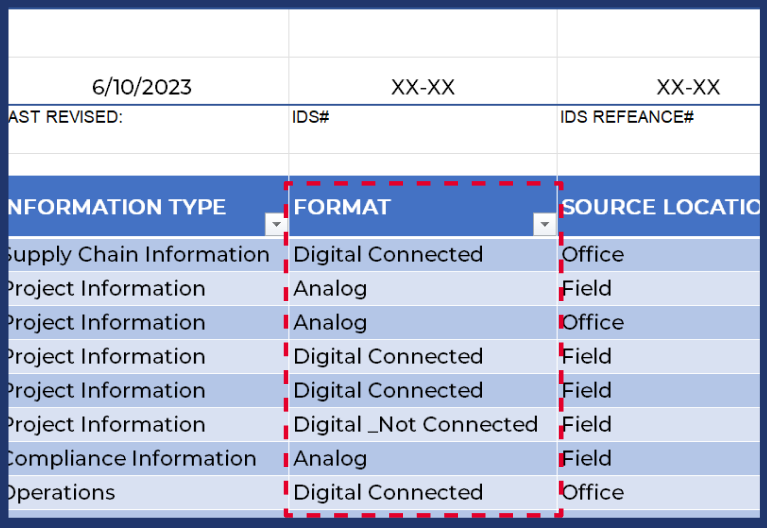Format
General
This field has a drop down for the parameters listed below. These represent commonly used parameter labels for data discovery but can be added to on the List Reference tab of the IDS.
Format
 In this field we are making a simple but important distinction between Analog and Digital information, adding an additional note on Digital information to indicate whether that information is connected to our organization's network or separated from it.
In this field we are making a simple but important distinction between Analog and Digital information, adding an additional note on Digital information to indicate whether that information is connected to our organization's network or separated from it.
In general, analog can be defined as a physical way to communicate information. Meanwhile digital, at some level, converts the information to ones and zeros to be communicated electronically. A clock is a good example. A traditional clock uses physical hands to point to two numbers or the distance between numbers to communicate the time. A digital clock expresses the time using binary code (ones and zeros) generated by a computer and displayed on an interface. This code can also be shared with other computers. Where that is the case, we identify the information as both digital and connected.
This field is most important when it comes to digitizing an organization or automating processes within an organization. This parameter will become a guiding instrument during the next section on digitization.
Best Practices
- Analog- Non-binary data or other information being physically conveyed.
- Digital Connected- Binary data connected to an organization’s information network.
- Digital Not-Connected- Binary data not connected to an organization’s information network.
Understanding Good Stewardship
 Analog data is continuous, so it has an infinite range of values, while digital data is discrete, broken down into binary code (ones and zeros) for easy processing by computers. This means that some level of detail may not come through when transitioning too digital, so understanding the level of detail required is important when digitizing any analog information. This becomes visually apparent when turning images into digital information. Standard document digitization changes images from continuous lines and colors into individual points close together (resolution) and can appear grainy with magnification. This same loss of detail occurs in music at some level which is why people often prefer vinyl records to early CD's.
Analog data is continuous, so it has an infinite range of values, while digital data is discrete, broken down into binary code (ones and zeros) for easy processing by computers. This means that some level of detail may not come through when transitioning too digital, so understanding the level of detail required is important when digitizing any analog information. This becomes visually apparent when turning images into digital information. Standard document digitization changes images from continuous lines and colors into individual points close together (resolution) and can appear grainy with magnification. This same loss of detail occurs in music at some level which is why people often prefer vinyl records to early CD's.

